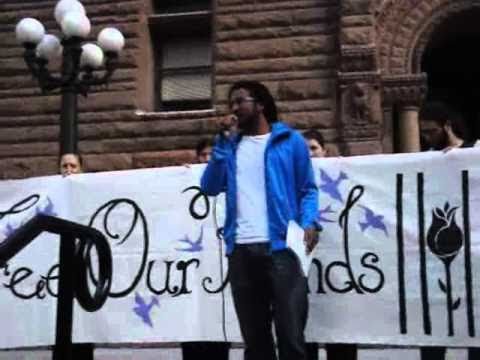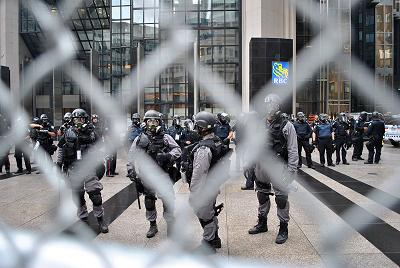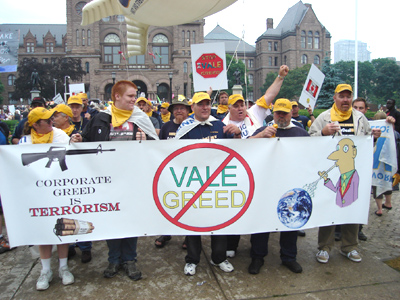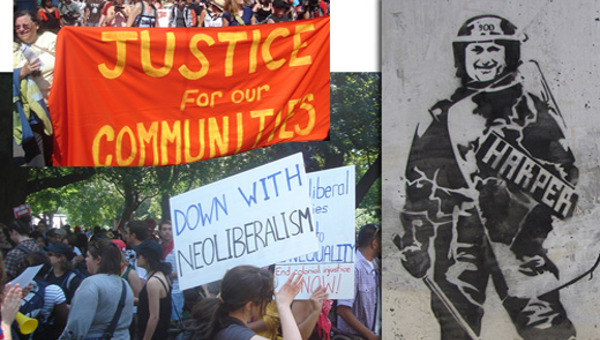G20 Protests: Fighting Back Against the Police State
On Monday, June 28, a large and boisterous demonstration of about 2500 people that snaked through the streets of Toronto continued the movement to rid this city of the police state regime that took over during the G20 summit. The leaders of the G20 had gone. As expected, their gathering had focussed on finding new ways to restore corporate profits by taking it out of the workers and the poor. But the movement against the police state regime and the G8/G20 agenda is continuing.
The police prepared for the protests by creating an inside-out prison, in which the inmates were “free” while the rest of us faced a lockdown. Gangs of heavily-equipped police roamed the streets and the subways. People were searched at random. Miles of wall were erected to keep us from Stephen Harper and his summit. An extraordinary regulation was adopted by the provincial cabinet in secret to suspend civil rights near the wall.
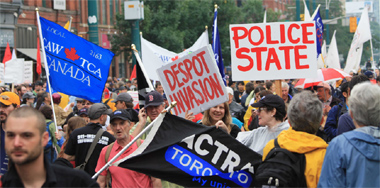
Heavy Hand of the Police
The demonstrations, actions and teach-ins against the G8/G20 were large, and seemed to draw in new layers of activists. The police presence was heavy-handed. For example, the Toronto Community Mobilization march on Friday, June 25 was penned in by an extremely heavy police presence, suited out in riot gear. The police drove the demo into back streets and away from its intended route.
The largest demonstration was the labour-backed “People First” march on Saturday, June 26, one of the largest protest seen in Toronto since the protests against the Mike Harris Tory government in the mid-1990s. There were probably 10,000 participants. The official march was one of those typical “road to nowhere” demonstrations that frustrates many activists by turning away from the site of the target of the protest. Two breakaways to march toward the wall were halted by the overwhelming police presence, and some demonstrators were beaten.
Then a group of people did break away, retracing the route of the original march in reverse. Some people from this group were involved in the fairly limited property damage (some broken windows and trashed police cars) that was very heavily reported in the media. I don’t think we can know at this point the real story of the role of the police in this property damage, as we do know that certain activist groups were heavily infiltrated and police provocateurs have in the past used Black Bloc garb as a cover.
What is clear is that the police used that breakaway as a pretext to stage a coup, essentially shutting down the right to dissent in Toronto. Tear gas, rubber bullets and mass arrests became the automatic tool for dealing with any protests. Journalists were roughed up. Activists were arrested at their homes. Places accommodating out-of-town protesters were raided. The Graduate Student Union at the University of Toronto was the site of one of those round-ups, and as I write members of the executive of the GSU are still being detained.
This police response is probably the greatest single assault on political rights in the Canadian state since 1970. In October 1970, using two kidnappings by the Front de Liberation du Quebec (FLQ) as the pretext, the federal government invoked the War Measures Act, sent troops onto the streets of Montreal and had about 500 people arrested, including labour and community activists, journalists and artists (most of whom had no connection to the tiny FLQ).
In Toronto, the excuse for the police state regime was the limited property damage committed by a relatively small number of people on the afternoon of Saturday, June 26. However one assesses the actual events of that day, the police response that followed was completely out of proportion.
The total bill for security for the summit was well over $1-billion. There was nothing spontaneous about the police actions. Police have been planning for months, and that planning clearly included the infiltration of activist groups.
Targeting Anarchism: New McCarthyism
In the week leading up to the summit, the specific targeting of “anarchists” became clearer. The Tories and the security services admitted the terrorist threat was low. But terrorism was not their real target. Cabinet minister Stockwell Day signalled a particular focus on “anarchists” for this security crackdown in speaking about “the unfortunate power that a small group of thugs has. And when I’m talking about thugs… I’m talking about the anarchists and the violent groups who have already indicated that they’re going to be there and they’re going to cause trouble.”
Sadly, others have participated in this targeting of “anarchists.” Canadian Labour Congress President Ken Georgetti issued a statement on June 26 that said “Our rally and march were entirely peaceful from start to finish. It appears that a small group of anarchists, who are unknown to us, became involved in some violent and destructive activities as the day progressed.” [Ed.: see “Open Letter to Ken Georgetti.”]
The police justified their attacks on peaceful demonstrators on Saturday and Sunday and their round-ups of activists from their homes and lodgings on the basis of accusations that Black Bloc activists might be among them. Prominent activists were snatched from the streets and thrown into unmarked vans. It seems that a longer-term strategy of targeting “anarchists” is being brought into play, fuelled by lots of prior overt and covert work by police and security organizations. It led to the mass arrests on Saturday and Sunday.
The crucial immediate task is the political defence of those who have been arrested. This huge attack on our protest rights needs to be taken up in a way that pulls the left together and opens up channels for respectful discussion and debate. We specifically need to challenge the targeting of anarchism, which is highly reminiscent of the McCarthyite tactic of labelling any radical a “communist.”
Need to Build the Movement
As we build a movement against the police state regime and the capitalist agenda it is protecting, we also need to create places to openly discuss and debate the effectiveness of various tactics used in these and other mobilizations. Specifically, activists need to discuss the relationship between tactics and the overall goal of mobilizing, rather than getting stuck on the idea that any specific tactic is always the best, entrenched in principle. We really need good discussions on why we protest.
Every protest (this side of the revolution) involves some combination of demonstrating our insurgent potential in the streets and registering symbolic dissent from the way things are. The precise balance between insurgence and symbolism will vary in specific circumstances, depending particularly on the goals of the specific action and an assessment of the balance of forces.
I come from a political tradition of “socialism from below” that is ultimately rooted in the idea that revolution is about the great mass of the population rising up and taking power with their own hands. Numbers matter, because we want more and more people to join in the project of changing the world. But it also matters that those involved feel that they are accomplishing something through their actions. The feeling of effectiveness will vary in different circumstances. The goal is to build mass militancy, where very large numbers use their power to bring the production of goods and services to a halt and create real democracy in the streets and in workplaces.
The G8/G20 police state regime is not exceptional, but is a warning of the direction Harper, the cops and the security services will go if we do not stop them. Protest against this police state regime is important in challenging this regime and the capitalist order it is protecting. This protest shows both the potential and the need to build a new left with the social weight to make a real difference, both in the streets and in political discussion and debates. We need to be able to mobilize in militant action against those in power and to persuade more people who do not support radical social change that it is possible to challenge this unjust order and their own activity can make a real difference. •
This article first appeared on the New Socialist webzine.


